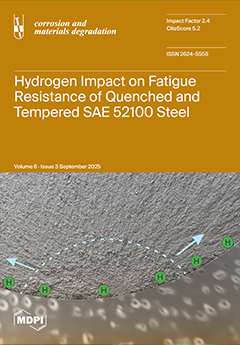This study investigates the effectiveness of calcined magnesium–aluminium layered double hydroxide (CLDH) as a functional additive for mitigating carbonation-induced corrosion in alkali-activated slag concrete (AASC). Mixtures incorporating different CLDH contents (0%, 2%, 4%, 6%, and 8%) were evaluated under accelerated CO
2 exposure
[...] Read more.
This study investigates the effectiveness of calcined magnesium–aluminium layered double hydroxide (CLDH) as a functional additive for mitigating carbonation-induced corrosion in alkali-activated slag concrete (AASC). Mixtures incorporating different CLDH contents (0%, 2%, 4%, 6%, and 8%) were evaluated under accelerated CO
2 exposure (3%, 65% RH, 25 °C) for 90 days. Mechanical characterisation was carried out through 28-day compressive strength tests to assess the potential impact of CLDH on the structural performance of the material. Performance characterisation included electrochemical impedance spectroscopy (EIS) to assess the corrosion of embedded steel, phenolphthalein spraying to determine the carbonation depth, and complementary techniques such as X-ray diffraction (XRD), nuclear magnetic resonance (NMR), and scanning electron microscopy (SEM/EDX) for assessments of the microstructural evolution. The results demonstrate that CLDH significantly enhances resistance to CO
2 ingress, increasing the polarisation resistance (Rp) to over 55 kΩ·cm
2 (at 6% CLDH) and reducing the carbonation depth by more than 50% compared to the reference mix. These improvements are attributed to the memory effect-induced regeneration of LDH-type lamellar phases, controlled release of OH
− and CO
32− anions, and progressive densification of the microstructure, thereby limiting the ingress of aggressive agents. The optimal dosage was identified as 6%, as higher contents offered no further improvement and evidenced the formation of residual phases such as MgO. This work highlights the potential of CLDH as an effective and sustainable strategy to enhance the durability of alkali-activated cementitious materials against degradation processes driven by carbonation and corrosion.
Full article





